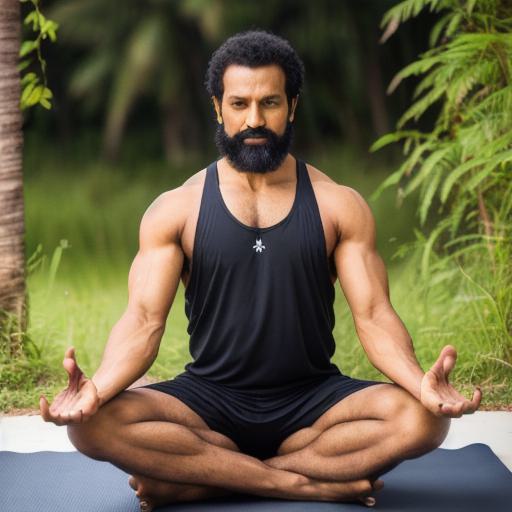Introduction:
Vaasi Yoga is a lesser-known practice that has gained popularity in recent years due to its numerous benefits for both physical and mental well-being. This article aims to provide an overview of the principles and benefits of Vaasi Yoga, as well as how to incorporate it into daily life.
Principles of Vaasi Yoga:
Vaasi Yoga is a practice that involves circulating energy or "prana" throughout the body by activating specific points called "vaasisthanas." These vaasisthanas correspond to different areas of the body, such as the heart, lungs, and digestive system. By activating these points through breathing exercises and meditation techniques, Vaasi Yoga helps to balance the flow of energy in the body and promote overall health and well-being.
The main principles of Vaasi Yoga include:
- Breathing Exercises (Pranayama) – The practice of pranayama is a key component of Vaasi Yoga, as it helps to activate the vaasisthanas and circulate energy throughout the body. By focusing on breathing techniques such as alternate nostril breathing or diaphragmatic breathing, practitioners can improve their respiratory function and overall health.
- Meditation – In addition to pranayama, meditation is also an important aspect of Vaasi Yoga practice. Practitioners are encouraged to focus their attention on specific vaasisthanas during meditation, allowing energy to flow freely throughout the body.
- Visualization – Visualization techniques can also be used in Vaasi Yoga practice to help activate the vaasisthanas and promote relaxation. Practitioners may visualize a warm, glowing light flowing through their body as they focus on specific areas.
- Movement – Movements such as yoga poses or stretches can also be incorporated into Vaasi Yoga practice to help activate the vaasisthanas and release tension in the body.
Benefits of Vaasi Yoga:
There are numerous benefits associated with regular practice of Vaasi Yoga, including:
- Stress Reduction – The calming effects of pranayama and meditation can help to reduce stress levels and promote relaxation. In fact, a study published in the Journal of Alternative and Complementary Medicine found that regular practice of pranayama can significantly reduce symptoms of anxiety and depression.
- Improved Respiratory Function – The breathing exercises used in Vaasi Yoga can help to improve respiratory function, which can be especially beneficial for individuals with asthma or other respiratory conditions. A study published in the Journal of Ethnopharmacology found that regular practice of pranayama can increase lung capacity and reduce shortness of breath.
- Better Sleep – The calming effects of Vaasi Yoga can also help to improve sleep quality, which is essential for overall health and well-being. A study published in the Journal of Clinical Sleep Medicine found that regular practice of yoga can improve sleep patterns and reduce symptoms of insomnia.
- Pain Relief – By increasing blood flow to specific areas of the body, Vaasi Yoga can help to alleviate pain and tension. This can be especially beneficial for individuals with chronic pain conditions such as fibromyalgia or osteoarthritis. A study published in the Journal of Complementary and Integrative Health found that regular practice of yoga can reduce pain levels in individuals with chronic low back pain.
- Increased Energy – By promoting the free flow of energy throughout the body, Vaasi Yoga can help to increase overall vitality and energy levels. This can be especially beneficial for individuals who experience fatigue or low energy due to stress or other factors.
How to Incorporate Vaasi Yoga into Daily Life:
Incorporating Vaasi Yoga into daily life is relatively simple and can be done in just a few minutes each day. Here are some tips to help get started:
- Set aside time for practice – Choose a quiet, comfortable space where you can focus on your breathing and meditation without interruption.

- Use pranayama exercises – Choose a pranayama exercise that works best for you, such as alternate nostril breathing or diaphragmatic breathing, and incorporate it into your daily routine.
- Visualize energy flowing through your body – Close your eyes and visualize a warm, glowing light flowing through your body from the top of your head to the tips of your toes. Focus on specific vaasisthanas as you do so.
- Incorporate movement – You can also incorporate stretches or yoga poses into your Vaasi Yoga practice to help activate the vaasisthanas and release tension in your body.
- Make it a daily habit – Consistent practice is key to seeing the benefits of Vaasi Yoga, so make it a daily habit to incorporate these techniques into your routine.
FAQs:
- What is Vaasi Yoga?
Vaasi Yoga is a lesser-known practice that involves circulating energy or "prana" throughout the body by activating specific points called vaasisthanas. By practicing pranayama, meditation, visualization, and movement techniques, practitioners can promote overall health and well-being. - What are the benefits of Vaasi Yoga?
The benefits of Vaasi Yoga include stress reduction, improved respiratory function, better sleep, pain relief, and increased energy. Regular practice has also been shown to reduce symptoms of anxiety and depression. - How do I incorporate Vaasi Yoga into my daily life?
Incorporating Vaasi Yoga into daily life is simple and can be done in just a few minutes each day by setting aside time for practice, using pranayama exercises, visualizing energy flowing through your body, incorporating movement, and making it a daily habit. - Is there any scientific evidence supporting the benefits of Vaasi Yoga?
Yes, there is scientific evidence to support the benefits of Vaasi Yoga, including studies that have found regular practice can reduce symptoms of anxiety and depression, improve respiratory function, increase lung capacity, alleviate pain, and improve sleep patterns. - Can anyone practice Vaasi Yoga?
Vaasi Yoga is suitable for people of all ages and fitness levels, and there are modifications available for those with injuries or limitations. It’s important to always listen to your body and stop if you experience any discomfort or pain during practice.



